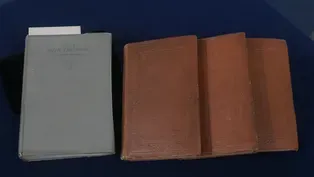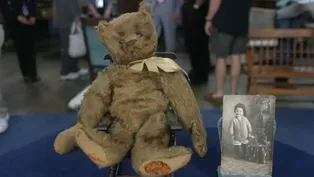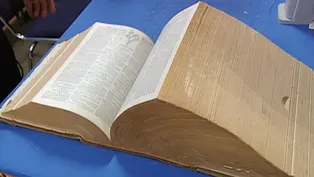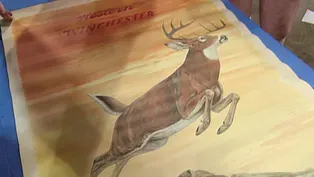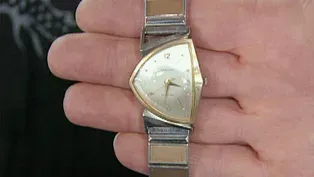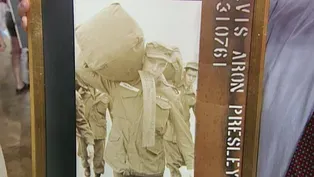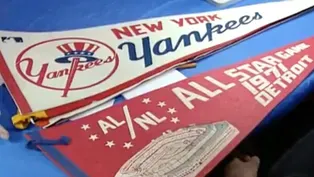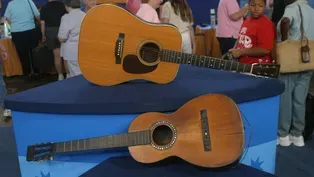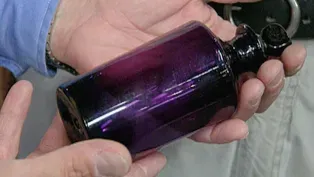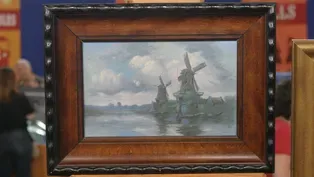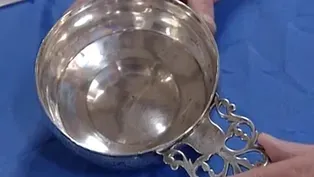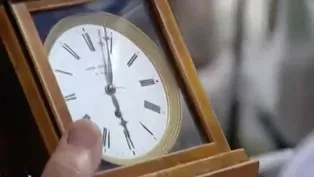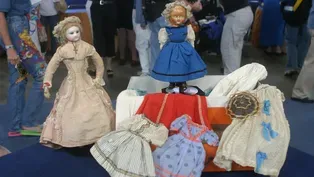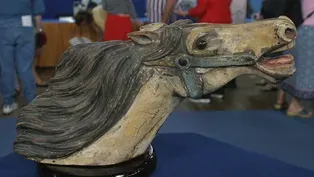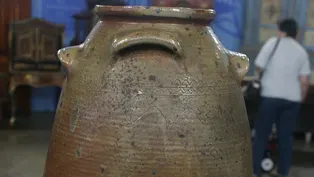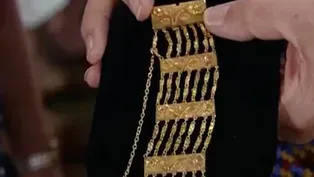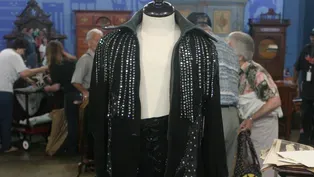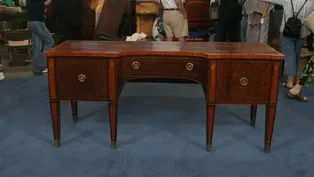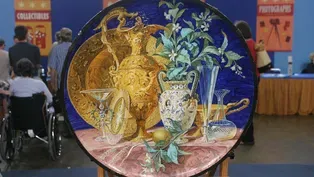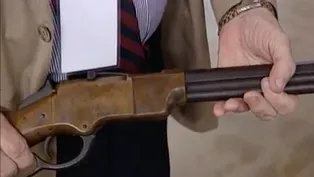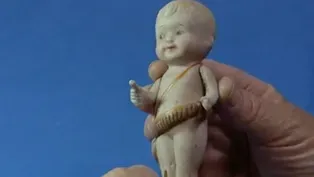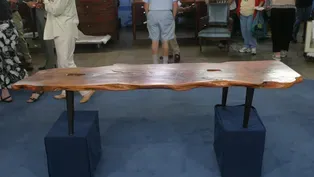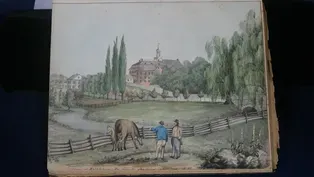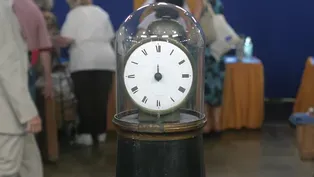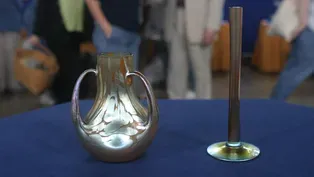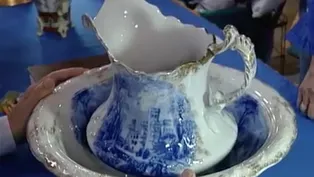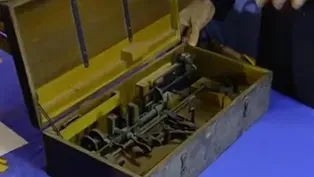

Vintage Memphis
Season 23 Episode 22 | 52m 31sVideo has Closed Captions
Marvel at magnificent Memphis treasures from Season 9, like a $100K updated appraisal!
Marvel at magnificent Memphis treasures from Season 9, including an Elvis Presley outfit from around 1970, a 1942 Grandma Moses painting, and A. Martin & C.F. Martin guitars. Learn which Tennessee find has an updated appraisal of $100,000!
Problems with Closed Captions? Closed Captioning Feedback
Problems with Closed Captions? Closed Captioning Feedback
Funding for ANTIQUES ROADSHOW is provided by Ancestry and American Cruise Lines. Additional funding is provided by public television viewers.

Vintage Memphis
Season 23 Episode 22 | 52m 31sVideo has Closed Captions
Marvel at magnificent Memphis treasures from Season 9, including an Elvis Presley outfit from around 1970, a 1942 Grandma Moses painting, and A. Martin & C.F. Martin guitars. Learn which Tennessee find has an updated appraisal of $100,000!
Problems with Closed Captions? Closed Captioning Feedback
How to Watch Antiques Roadshow
Antiques Roadshow is available to stream on pbs.org and the free PBS App, available on iPhone, Apple TV, Android TV, Android smartphones, Amazon Fire TV, Amazon Fire Tablet, Roku, Samsung Smart TV, and Vizio.
Buy Now

ANTIQUES ROADSHOW 2025 Tour!
Enter now for a chance to win free tickets to ANTIQUES ROADSHOW's 2025 Tour! Plus, see which cities we're headed to!Providing Support for PBS.org
Learn Moreabout PBS online sponsorshipIf we chose to buy one, we could have one, and she would frame it, right there on the dining room table.
Oh, my gosh.
So you have great, great books.
Oh, my gracious.
Wow.
(woman and appraiser laugh) ♪ ♪ MARK WALBERG: "Antiques Roadshow" appraisers made music... (playing instruments) ...and made people's day... What?
(wheezes) WALBERG: ...back when we visited the Home of the Blues in 2004.
But has the market changed its tune since then?
Find out in this fresh look at Memphis.
Here we are in the home of the King, and you've brought us an outfit that belonged to Elvis Presley.
Where did you get this outfit?
My husband bought it at an auction in 1975 in Germantown, Tennessee.
The Jaycees auctioned it off.
They went to Graceland to acquire something that belonged to Elvis, and Vernon Presley was gracious enough to give them the, this particular suit, along with a letter that he signed saying it was Elvis's suit.
Okay, do you have any pictures of Elvis wearing this or anything like that?
I do not.
Uh-huh, and what did you pay for it?
My husband paid $1,250 for it.
Well, it's no secret that Elvis Presley loved clothes.
And he spent a lot of money on his clothes.
In fact, he had them custom-made.
This is a one-of-a-kind outfit.
It's all made by hand, and it's very well-done.
There are several problems that come along with trying to find the value of an outfit of any kind that belongs to a well-known person.
If we had a photograph, that would be a wonderful way to find out exactly when this was worn, because it has several different values depending on if it was worn and when it was worn.
Do you have any idea about when it might have been worn?
I do not.
Well, if this happened to be one of those outfits that he wore on his '68 comeback tour, it would be worth a great deal of money-- probably about $100,000.
I've talked to several people here, and they seem feel it's probably a little bit later, probably in the late '60s, early '70s, and probably for Vegas.
If it was worn on stage-- and it appears to be worn by someone, because there's a good bit of wear around the neck and on the inside, and probably was quite active while they were wearing it, maybe dancing or whatever.
If he wore it at that time, it would probably be worth about $30,000.
And if, on the other hand, he just owned it but never wore it, it would drop down to around $15,000.
So today, we really can't come up with a, a definite value because we need to know more information about that.
But anyway, even if it's worth just $15,000... That's... That's all right, Mama!
That's all right.
And if anyone has a picture of him wearing it, I would sure like to have that picture.
Right.
(laughs) MAN: I had a collection of over 600 ceramic pots.
When we downsized, we went into a much more convenient and appropriate living quarters.
I was talking to a gentleman.
He says, "You know, you got a great collection here."
He says, "Would you allow me to go out to my car, and I want to show you something?"
He comes back in, stands in front of our sofa, and three out of four he dropped on that couch.
And he says, "I'll trade you even, these for those."
All 600?
Yes.
My wife was listening, and she says, "Those we can hang on the wall.
The pots got to go."
I'm a married... happily married 39 years to this woman, I don't argue with her.
I've been taught, "Yes, dear."
That was my answer.
(laughs) I now have 34 of these at home, and I'm fascinated by them.
So you have two beautiful Rookwood plaques.
Right.
Which one's your favorite?
That one here.
That one there.
And that's also earlier.
That was painted by one of their best artists, Mr.... you can call him "Valentien" or "Valentine," done in 1896.
All hand-painted under this beautiful green overglaze.
This could be called a sea-green plaque.
It's really pretty spectacular.
And this is by Fred Rothenbusch.
The "F.R."
right here.
Right.
This is so unusual for him.
He made many different scenic vellum plaques, but this one is so active, it's so alive.
It's got all this choppy water, and it's a beautiful, probably Dutch, scene, and the clouds have so much movement and motion going.
It's a very, very good plaque.
Newcomb College.
Yes.
You had Newcomb pots.
Yes.
They didn't make a lot of these.
Sometimes you see the little tiles that are hand-built, but these big, beautiful plaques like this-- especially the ones with the live oak trees and the Spanish moss-- that is so rare.
And the last one is made by Marblehead, from Marblehead, Massachusetts.
Yes.
Also, you may have had some of the Marblehead pots.
I had quite a few.
But they didn't make many tiles, and a lot of the tiles that they made weren't very interesting-- they had ships on them, they were for the tourist trade.
This is a special Marblehead tile.
$2,000 to $3,000 on a bad day.
Mm-hmm.
Your extremely rare Newcomb plaque, $10,000 to $15,000.
This lovely sea-green... another $10,000 to $15,000.
Mm-hmm.
And probably the most valuable-- not necessarily the best or the most beautiful-- is this one at $15,000 to $20,000.
You're not hurting my feelings, my dear.
I wasn't, wasn't planning on it.
APPRAISER: How many pages did you say was in this?
WOMAN: Over 7,000.
Over 7,000.
So it's the largest, thickest dictionary.
Nobody here has ever seen this.
It must have been a promotional or some kind of a experimental dictionary.
My friends asked me how many words are in it, and I tell them, "All of them."
APPRAISER: It's Biedermeier-- well, that's the style.
And the Biedermeier style is very plain, light fruit woods.
Absolutely fabulous little example.
What it is is a World War I bombsight.
Correct.
What makes it also interesting is that it was manufactured by the Edison Company.
Before there were actually any bombsights during the First World War, guys were just kind of guessing, dropping things out of planes.
I mean, it really was for compensating for windspeed.
I believe it has been in my family for six generations.
The last two are not engraved on the front, the others are.
I thought it came from England, but that's all I know about it.
It's not English, it's American.
And it was made by a gentleman by the name of Benjamin Burke, that's this mark here on the handle.
It's a porringer for a child.
As far as value goes, we're talking somewhere in the range of $6,000 to $8,000.
You are kidding!
No, I'm not.
Oh, my word.
Made in Boston, Massachusetts.
Oh, my goodness.
My sister's going to wish she hadn't let me have that.
(chuckling) Oh, my goodness, that is amazing.
MAN: This little bear belonged to my father.
He is 95 years old.
The picture here shows my father with the bear at age two.
APPRAISER: Now, he gave the bear a name.
The bear, it has always been known as Ted.
I have photographs of, of me actually at my first birthday and second and subsequent birthdays, with all of my toys, and Ted was always there.
He's a mohair teddy bear, and he is German.
And did you know anything about manufacturer or anything like that?
There are no markings, no tickets, labels, or anything that we ever could find to make sure.
We always were in hopes that he was a Steiff.
Well, in fact, Ted is a Steiff.
Is that right?
He does have the original button in the ear, and it's the button that has the underscored F at the end of "Steiff."
And that's an early button, and it ties him to the right period, everything.
He's a nice, light brown, mohair teddy bear.
Right.
Now, obviously, Ted has had quite a life.
He shows a lot of wear.
Yeah.
You see the pads have worn.
We see here that the pads have been replaced or covered up with a patch.
I wondered about that.
And he's lost some of his excelsior stuffing here.
Right.
So he's a little bit folded up in the stomach.
His muzzle has some loss.
He has some mohair loss.
But all those years, he's been on display and loved, and Margarete Steiff made the teddy bear to do just that.
And that's what's great about Ted.
And what's going to happen to Ted after?
Well, I have two wonderful children, that I hope one of them will take care of Ted for the rest of their lives.
Right, he has a lifetime of being exposed, and there's a, a heavy residue of dirt on him.
We don't recommend cleaning all the time, but it might be okay to brush Ted.
Well, he's so fragile-looking that we were really afraid to do anything to him, so he's natural.
How long has he been in the chair?
He's been in the chair 30 years.
Yeah, well, based upon his condition, Ted's value would be $2,000 to $2,500.
Is that a fact?
Yes.
Well, he's worth a lot more than that in my heart.
Oh, absolutely-- he's priceless.
He's, very much so.
If Ted was in perfect condition, he would be probably around $4,500, $5,000.
Wow.
WOMAN: It was handed down in my family.
It belonged to my grandmother, and she got it on a wedding trip to New York, back, probably, about 1918.
And then my mother got it.
When my mother died, I received it.
APPRAISER: What have you found out about it?
I've gone to some jewelers, and, you know, they say, "Oh, it's pretty, but we don't know anything."
And what do you think it is?
Honestly, I don't know.
Do you think it's real?
I don't know.
I mean, it could be a piece of glass.
I think it's pretty, and I just like the design and... You know what?
You're on the right track.
It is a piece of glass.
It's frosted glass.
Mm-hmm.
But it's made by a great French maker, very, very rare.
We found the signature-- I was looking.
I said, "This looks better than just glass jewelry."
Uh-huh.
And right in the back of this is a signature.
Oh, my.
And it says, "G.
Fouquet."
Georges Fouquet comes from a great French jewelry house.
His father, Alphonse Fouquet, started the firm back in the 1800s, and Georges continued the firm until about 1930s; when the crash came, they closed it.
And then his son, Jean, actually worked with him, then continued.
It's quite rare.
Oh.
You know, these are diamonds.
I thought maybe they might be.
Yeah, they were diamonds.
The metal could be white gold, doesn't necessarily have to be platinum, because Jean Fouquet, the son, didn't really care for white looking like platinum.
He liked blackened white.
He liked odd materials.
The material was not what's important-- it was design.
And the son, Jean, I think, is actually who designed it, because he was known for large planes, flatter surfaces.
But I see you changed it, or your mother shortened it.
My mother did that, right.
And made some earrings, because...
Exactly.
it was very long, because that was the style then.
So, the earrings are really not worth much, but if we add up the glass and the few diamonds, it doesn't amount to much.
But this is where design is everything.
So I'm going to say, conservatively, $10,000 to $15,000.
Oh, my gracious.
Yeah.
So what do you think?
A nice piece of glass, huh?
(chuckling): It is a nice piece of glass.
WOMAN: This is a sword that belonged to my great-great-great-grandfather.
He was in the Mississippi cavalry in the Civil War.
APPRAISER: Right.
And I'm real curious, first of all, to authenticate it.
Right.
And also to see what, what it might be worth.
It is 100% original.
Oh, great.
In the field of Civil War collecting, these are the magic letters.
Oh.
When you have "CS" in the guard, that stands for "Confederate States."
Mm-hmm.
To a collector, that's what you want to see.
Okay.
And he evidently was an officer.
Oh.
Because this is the staff and field officers' version, because of the letters.
Okay.
They call this a floating CS.
It's a brass guard.
The guard was cast, then they applied the letters to it.
Okay.
The sword itself was made right here in Memphis.
Really?
There was a firm called Thomas Leech and Company, also known as the Memphis Novelty Works Company.
Very famous company in Civil War collecting.
A lot of people will look at a sword like this and think, the blade's rusty.
Certainly.
The grip originally had wire.
Oh.
The wire's missing.
The tip, broken off.
Oh, it is?
And a lot of people will say, "It's just an old, rusted sword."
Yeah.
But it's the history that goes with the sword, not so much the condition of the sword.
When I got here, I thought, "Maybe I should have cleaned this up."
But was it better to not do anything?
Yeah, I'm glad you didn't, because there are a lot of reproductions of this sword.
Oh.
They manufactured quite a few reproductions of them.
Okay.
This one's not, but when you get into the cleaning aspect of it and the polishing... Uh-huh.
It all sends up a red flag that maybe they're covering up something.
Oh.
But to a collector... Uh-huh.
It's a beautiful piece.
There are a lot of these swords that are in the attics, in the barns... Mm-hmm.
And they need to get out there and see if, what they are.
Right, right.
Because you never can tell when you're going to have a gem that doesn't look like a gem.
Exactly.
So how much of a gem is it?
Well, if I was going to insure it... Mm-hmm.
I'd want to put $7,000 on it.
Wow.
(both laugh) Okay.
I've got chill bumps now.
(both laugh) WOMAN: I bought it many years ago out of a house sale, and I was not into clocks at all.
And the woman sort of pushed it at me.
I saw the name on it, Simon Willard, and I thought, "Well, you know, that name rings a bell," being from Massachusetts.
So I said, "Okay, I'll take it."
It didn't take long for me to figure out it was a lighthouse clock, but I didn't know this style.
I always remembered the mahogany ones.
And originally, each side had wreaths and gold gilt and acorns, but they have sort of disintegrated through the years.
Now, how long ago was it that you found it?
Over 20 years ago.
I also am from Massachusetts, and over the years have seen a small number of these clocks.
The thing that's interesting about them and Simon Willard is that he invented this particular movement and this form, which is distinctively American.
Yes.
There's a relatively long period where these clocks were made-- 20 or 25 years.
You will see these clocks in a variety of cases, and they vary in quality.
One thing that's very evident is that the dome, as you know, is not original.
Yes.
The original dome would have been hand-blown, it would have a ring at the bottom, it would taper towards the top, and there would be a big knob handle.
Instead of having to go like this, which we will do, you would have lifted the handle off.
You had to take the top off to access this.
This is how you wound the clock up.
Ah.
So a lot of the original glass domes, I daresay, almost all of them are long gone.
We can talk a little about the brass bezel, this beautiful enamel dial.
This clock is, boy, it's "as is," if there ever was one.
The hands have been broken off.
We look at this detail of the mechanism.
Now, this movement is unique to Simon Willard.
This had an alarm.
Oh, really?
So this would have run with two weights.
When this alarm went off, this bell would be hit repeatedly, and it would be enough to wake everybody in the neighborhood, never mind in the house.
And you can see this very distinctive suspension, what's left of it.
Now, you've indicated to me, I think, that this is the way the clock came.
It has, it has no pendulum.
Yeah, I never got a pendulum.
No rod and no weights.
The thing that tantalizes me about it is that it has yet to be restored, so at least no mistakes have been made.
If we remove this, you can see that the movement is mounted on this wrought-iron plate, and it's made like a barrel.
This is made in section.
You can see that there is canvas applied to the inside to keep it basically together.
Mm-hmm.
This painted surface is very darkened over the years, but it has Classical, Greek revival motifs-- the Greek key, and these wreaths with the oak leaves and acorns.
Some of it is still there.
Now, when we turn the clock this way, we can see that at some point, somebody cut a hole in the bottom, presumably so the weight would fall a little longer.
Oh.
And it would run a little longer, you wouldn't have to wind it so often.
There's a limit as to how much advantage that made.
I didn't realize that.
And two of the feet have been replaced.
The feet on the back, they've added these little wafers so that it wouldn't wobble too much.
So here's a fantastic, rare timepiece, patented by Simon Willard in the early 19th century-- I would guess about 1820, 1825.
It's not the best case they ever produced by far, but it's absolutely fascinating.
Now, when you purchased this piece, what did you pay for it?
Eight dollars.
(chuckling) You sure this wasn't 200 years ago?
(laughing) All right, eight dollars.
It's just, that just...
I didn't want it, so... Well, you got it.
All right, at any rate, there's some precedent for these clocks bringing all kinds of money.
I think this clock, taking into light there's some condition problems.
Nonetheless, I think the clock is worth, well, probably somewhere between perhaps $75,000 and $100,000.
And I'm so glad that somebody finally convinced you to buy it.
APPRAISER: This is the naked gun, it's a little Japanese bisque doll, styled after a Kewpie doll.
APPRAISER: It says right here, "Wedgwood."
And Wedgwood, of course, is a great name in English pottery-making.
But it's not Wedgwood.
Because it's such a great name, other companies kind of traded on the name a little bit.
Really?
Yeah.
And this, you see, is "Wedgwood and Company."
A little subtle "and Company" in there.
That means it's not Wedgwood.
MAN: I was nine years old when I went to the game, and I remember pennants being 75 cents at the time.
A pennant like this was 75 cents, and this was $1.25.
APPRAISER: You said you picked up this watch where?
MAN: This was my dad's watch, and he died in 1990, and I've had it since then.
And my mother bought it for him in the late '50s or early '60s, as a present.
This particular watch was called the Pacer.
Hamilton made it.
It was Hamilton's first electric wristwatch.
Oh, wow.
They were the first to come out with electric wristwatches.
They made many different models-- the Ventura, the Saturn, the Titan, a lot of space-age names, because it was space-age technology for the day.
A little electromagnet caused the balance to move by way of the power from the battery.
This particular model was made in 1957.
Oh.
This one is gold-filled.
It's worth today about $600 to $700.
That's really great.
They did make some of them in 14-karat yellow gold-- rare and hard to find-- could be worth three times that.
But, uh, any given day, a, a very nice Hamilton electric watch, though.
My dad would be really happy.
WOMAN: I owned a little antique store for about a year.
And we were put in contact with a gentleman that was selling his father's estate.
He told us that his father worked for a company and that this gentleman that made the furniture for this company was under commission to make special furniture, and that it was an unsigned piece, and that the gentleman gave this table to his father and that it possibly could be a George Nakashima.
It is a very natural slab of cypress and probably made at the time, certainly, that George Nakashima was working.
Now, we've seen Nakashima furniture here on the "Roadshow" before.
And of course, he's called the grandfather of the crafts movement here in America.
He was a Japanese-American, and made furniture of natural materials.
And as we can see, there is this plank which is just as though it were cut off of a tree and, and polished a tiny bit.
Right.
But you can see its undulating form, its irregular form.
It still has knotholes in it here that have just been polished to use.
Let's flip this over.
You can see that there are two pieces of metal holding this natural piece of wood together.
Now, it is not the kind of construction that we would see Nakashima making.
We would have expected him to make a beautiful... what's called "dutchman" in cabinetry, and it would be a butterfly hinge-- it would look like an hourglass or butterfly wings.
Oh, okay.
And he would have held the two pieces of wood breaking apart together with that.
Another thing that I would look at are these legs and the fact that they are painted black.
I would have expected a Nakashima table to have a natural wood and much more of a canted leg.
These legs are quite straight.
So the table has a little bit of a stiff quality to it, where Nakashima is known for his grace and elegance and, and natural design.
Right.
So I'm not thinking that this is a Nakashima table, although possibly made in the New Hope area where he worked by some of the other craftsmen.
How much did you pay for the table?
Do you..?
We paid $400 for it.
$400, okay.
A Nakashima table would be selling in the $30,000 range, a lot of money these days.
His prices are just continuing because this modern movement is so popular.
And I think that that is helpful for this generation of furniture, because it sort of rides on the coattails of Nakashima.
Mm-hmm.
This table, I would say probably would bring about $1,000 at auction.
We'd call it "in the style of George Nakashima"...
Right.
"School of George Nakashima."
Right.
But not by him.
You've brought us two guitars here today, and I can see right away that they were made about a hundred years apart-- one circa 1850 and one in 1946.
The old one I bought here in Memphis, and I paid $35 for it.
And what's the story with the new guitar?
Well, a friend of mine had hocked it, and he couldn't get it out of hock, so I gave him ten dollars for his pawn ticket, and he had hocked it for $25.
$25.
Yeah.
Plus the ten dollars, means you got about $35 into it.
Right.
One thing that strikes me about these two are the similarities in their construction, even though they look very different.
The evolution of guitar-making started with this, in the 1850s in Europe, to this, which is really representative of the highest point of American guitar-making, which was around the Second World War.
This one has a much more European design.
Based on classical styles, it's smaller, and we call it a parlor guitar.
These guitars had a very sweet sound.
This one is in a very pure state of preservation.
There hasn't been really anything put on it that wasn't original.
It has a very patinated surface with all of these scratches and wear marks.
You don't want to clean this, you don't want to polish it, and you never want to refinish it.
And here we see a beautiful antique inlay around the sound hole.
We see an ebony fingerboard and the old design of peg head, which was a slotted peg head and they would ebonize it.
In other words, they would paint it black.
A hundred years later, this is the Martin Company of Nazareth, Pennsylvania.
This is a 1946 model D-28, and this happens to be one of the most sought-after guitars in the world by country artists, rock artists, everybody who wants a big, booming sound.
And the similarities with this one are the inlay around the sound holes.
When we look at the flip side of the guitar... we see all of those wonderful belt buckle scratches.
(laughs) You don't want to do anything to that, leave it how it is, and the zipper inlay in the middle.
Yeah.
Another similarity-- they're both stamped in the center strip.
In this one, you can see a stamp that says, "A.
Martin."
When we look into this one, we see the same type of traditional center stamp with a "C.F.
Martin."
A. Martin-- we don't know who it is, but it could have been a, a guitar maker in Saxony, Germany, about 1850 or 1840.
This one, as is, worth about $1,000.
Oh?
To play it, you'd probably want to put in about $1,000 or so, and it would be worth $2,000.
Yeah.
The parlor guitars are not as collectible as the big Martins.
You've got $35 into this?
Right.
It's worth about $12,000 to $15,000 now.
Mmm.
Not a bad investment.
I go yard-saling on Saturday mornings, and I went to a yard sale, and I was looking through some books, and I found this one and so I bought it.
APPRAISER: And how much did you pay for it?
25 cents.
When I first looked at the book, I noticed that most of the watercolor and gouache, which is another kind of watercolor painting...
Most of the pictures were of flowers.
A whole variety of different fruits and flowers.
Then I noticed... on this picture, which I think is pretty spectacular, it was clearly signed, "Rufus A.
Grider."
In the Victorian times-- late 19th century-- it was common for people to do these books or albums of studies of botanicals.
It was a popular hobby.
But what gave me the idea that it might be more than just a hobby was when I saw this inscription.
There's a number of pages, in addition to the flowers, that are sort of like an autograph book.
So this signature, which says "John Peck," Rufus Grider has inscribed underneath, "My schoolteacher who presented me with a box of watercolors."
So that gave me an idea that maybe he really had been an artist.
Then I saw, in addition to the flower pictures, this really lovely landscape, which is inscribed below "View of Bethlehem"-- that is, Pennsylvania-- "from the lowlands."
And this gave the artist a whole other dimension.
But what really stopped me in my tracks was when I saw this picture.
This is wonderful.
I went back to the computer and I typed in "Rufus Grider," and he comes up as an art teacher who worked in Mohawk Valley, New York.
He moved there from Pennsylvania.
And he really never made it as a big-time artist, but in addition to being an art teacher, he was a historian, he was a lecturer, he did a lot of research, and he devoted a lot of his time and energy to recording the history of that region and going around and painting old houses and landscapes, and left about 2,000 works to posterity up there, which really records the Mohawk Valley.
This is just a wonderful album.
It has so many terrific images in it.
I hope that it could stay intact.
It would really be a crime to see it all be separated.
(laughs) And I really think that together, it might be as much as $20,000 to $30,000.
What?!
(wheezing) This picture alone, someone might pay between $10,000 and $15,000 for.
It is so charming.
It has a child in the rocker with a dog and this wonderful carpet.
It's really an icon of folk art, not to mention that you have all these really gorgeous botanicals.
There's about 80 flower pictures in here.
Mm-hmm.
It's really a great buy for 25 cents.
(laughing) I can't believe that.
Oh.
I may take the day off.
(laughing) MAN: We have a picture of our friend Elvis, made when he was going in the service.
You took this picture?
Yes.
Yeah.
And they made this... stencil for him to do his barracks bag, and he was moving from one area to another to use the stencil.
And he put the stencil in his mouth, 'cause he had... doesn't have a free hand.
You were telling me a cute story about a woman who had come and said, "Which corner did he have in his mouth?"
And then found that corner and... She kissed it.
This is one of the more collectible Sandwich glass pieces that you find on the market.
The amethyst color is very, very desirable.
It dates from about 1820 to 1840.
Usually, the stopper is lost or broken.
(chuckling) This is not, which makes it very unusual.
APPRAISER: This is a collection of Ethiopian crosses.
Tell us how you came to own this collection.
WOMAN: Well, I've acquired these over a period of years online.
Okay, and you said a couple of them came from a United Nations representative, or... Three of them-- this one, this one, and that one-- came from a U.N. envoy.
They were brought out of Ethiopia in the '70s.
Great, and you believe that those might be old, and the others you think are probably decorative?
The others... yes.
These, possibly.
Okay.
These were from another collector, and they may be old, as well.
My first visit to Ethiopia was 1971.
Ah.
And they already had a cottage industry in these crosses.
They did have some old small ones, and some of the handheld ones.
But what we have here, and your total investment now is what, about $300?
Uh, between $300 and $400, yes.
Okay.
The bad news is, we have a collection of all new ones.
Oh, they're all new?
They're all new.
Oh, okay.
And what we're going to look for when we hold them, you want to rub your fingers like this on the edges and see if they're sharp.
If they're sharp, then that tells you they have not been handled.
WOMAN: Okay.
And then stylistically, you want to see how tight the design is.
This is a little crude.
Oh, okay.
Okay?
And then the final thing is, you want to look along the shaft, where it would be held, and you want to see whether it has a change in patine.
As you see, the patination is totally the same.
Yes.
It's not different.
Oh, okay.
And so therefore, it tells you right away, "This has not been held and used."
Now, that's the bad news.
Oh, okay.
The good news is that in the decorative market, the handheld ones can certainly go $100 to $150.
And online and in some of the galleries I've seen, the processional crosses go up to $300.
Oh.
So you actually have a beautiful, decorative cross collection.
Okay.
And you did very well.
Well, thank you.
Even though it wasn't exactly what you thought it was.
It's okay, I got them because they're beautiful.
WOMAN: My grandmother gave me these dolls when I was 16.
I grew up in Connecticut, and brought them to Memphis when I was 23.
As I grew up, she would show me these dolls, but I never could touch them.
And I guess she waited until I was 16, so I wouldn't play with them.
Well, you have two dolls from two different countries.
The lady right here next to you is a French doll, and she's commonly known as a French fashion doll, or Lady doll.
And this is a child doll right here.
She's made in Germany.
This was made in the Sonnenberg area of Germany.
This was made in Paris, France.
The fashion was made by a company called Bru, B-R-U.
And she has a bisque head, shoulder plate, glass eyes, a mohair wig, which is goat hair, her original clothes, her original jewelry.
She is missing her shoes, and her body's all leather.
This particular doll-- the little Sonnenberg doll-- has a wax-over- papier-mâché face, and then composition hands with swivel joints right there.
Her eyes are closed.
Do you know anything about that?
I really don't.
I would tilt her from time to time to see if I could see the eye, but... Uh-huh.
Well, let's see if we can do something with her.
We're going to pull this little lever, and her eyes open.
Where is that?
And then you push the lever down like that, and the eyes shut.
Oh, my.
Where is that little lever?
The lever's on the side of her body.
Oh, my goodness!
Well, anyway, anyway, they're, they're both from the same era.
They're from the late 1860s, maybe as new as 1870, but I would put them, like, 1865, sort of Civil War era.
(exhaling) The little Sonnenberg doll-- all original clothes, original shoes, original hair, super original little wardrobe.
And you actually have the, the paper trunk that she came in.
Yeah.
The wax-over has darkened with age.
Values: the little Sonnenberg doll with her wardrobe-- probably $1,200 to $1,500.
Now, the Bru fashion, even though she's missing her shoes-- you can find original shoes for her-- she's more in the $3,000 to $4,000 range.
She is?
Right.
Oh, my.
So probably around $5,500 for the grouping.
Those are nice dolls.
Yeah, they're lovely dolls, and they're in lovely condition.
WOMAN: My aunt passed away recently.
And in the late '70s, she came to visit me in Texas.
And we went to an antique show, and we saw this horse's head, but it was painted dark brown, and someone had rubbed green over it.
So she had it in her attic all these years.
And I decided to strip it down when she passed away.
I, I wanted to see what kind of wood was underneath.
Right.
And when I stripped it, this was what was underneath, and I can't imagine anybody putting brown paint over this, but that's what was there when I stripped it off.
Didn't you tell me they were asking $75 for it?
Yes.
She got them down to $50?
$50.
She said, "If you come back the third day of the show and nobody's bought it, I'll give it to you for $50," and that's what she paid for it.
Wow.
The way they made these things was... Uh-huh.
They made them... Of course it's carved out of wood.
Yes.
And... You can see that there's several different pieces of wood laminated together here.
Yes, I saw... And this is the head off of a carousel figure.
Carousel.
The thing that makes it so wonderful is the details in the carving, like this really nice, flowing mane.
I love the open mouth, and in horse talk, he's, he's short in the tooth, so he's still pretty young.
Oh, is that what that... oh, okay, I didn't know that's what it meant.
And you got glass eyes and the jewels here, but this was made during the peak time of production, especially in the Philadelphia area.
Uh-huh.
Probably 1890 to 1910, somewhere in that time period.
Oh.
The further they got in their production, the more demand there was for the figures.
As the carvers aged and there weren't people coming in with the same level of skill, then the quality level of what they were doing dropped.
Oh, oh, I see.
That's why I say this is from the golden time.
I know you're not a professional restoration person... No.
But the quality of the job that you did taking that overpaint off is amazing.
You saved all this craquelure.
Yes.
You must have just done it painstakingly slow, a little bit at a time.
I did, yes, I did.
You know, the thing that always draws us into objects... Uh-huh.
...is quality and eye appeal.
Yes.
And in, in the case of folk art and things like that, surface.
I bounced this off my colleagues and we feel very comfortable.
Uh-huh.
This would sell for $2,000 or $3,000.
Oh.
Without a doubt.
Oh...
Without a doubt.
Oh, well, I... Oh, well, I'm, I'm thrilled.
I think it's so pretty.
I think he's wonderful.
WOMAN: This honey pot belongs to my husband.
He inherited it from his grandmother.
She died in, I believe, 1952, and it came from her grandmother.
And it's been in our house for, I guess, about 50 years-- mostly in our house.
He had a men's shop, and he used it for umbrellas for a while, but I persuaded him to bring it back home.
And as far as I know, it has never been appraised.
But I do recall, I believe it was in the late 1950s, he received a letter from a lady who had seen the honey jar in his grandmother's home.
And I believe she wrote an article for some antiques publication.
And she told him that it really belonged in a museum.
He thinks she said in the Smithsonian.
I don't really know.
But he thinks it's very old, and, and we think it's lovely.
Well, you're right, it is lovely, and I don't think she was overreaching when she said it should be in a museum, and perhaps the Smithsonian.
Uh-huh.
Do you have any idea where this pot was made or by whom it was made?
No, we don't, and, and I asked my husband about that, if he knew where his great-great-grandmother came from.
He thought the family lived in middle Tennessee for a while.
You have a very, very important honey pot.
It was a very large hive of bees that would have had to fill this one, I can tell you.
Yes, yes.
I can barely see you over it.
But this very large stoneware pot was made in Tennessee...
In Tennessee?
Middle Tennessee.
Oh...
It was made by the Craven family of potters.
That was typical in Tennessee-- the early potteries were run by families.
Oh, uh-huh.
The Cravens came here from North Carolina.
This is unusual for its size.
Mm-hmm.
It's in superb condition, and it's very distinctively Craven.
Mm-hmm.
I was fortunate to have along with me a copy of the exhibition catalogue... Oh.
in Nashville, at the Frist Center of the Visual Arts in 2003, 2004, where a very similar pot marked by Craven... Craven.
...was in the exhibition.
This particular pot has all the Craven characteristics-- the ovoid shape... Mm-hmm.
...the great crimped banding around the middle.
Mm-hmm.
Which serves another purpose.
Oh.
This jar was so large, they had to do it in two sections.
We wondered about that, uh-huh, uh-huh.
They joined the two sections together in the middle...
I see.
Covered that connection with a crimped band.
The wonderful offset handles at the top... Mm-hmm, mm-hmm.
...are also distinctive and very decorative.
And being offset, you could grab the pot from either side.
Yes.
It has wonderful incised-line decoration and banding here.
As a rare Tennessee example and one of the best that is probably out there, this is a fairly valuable item.
It's very hard, when there are not many others like it...
I see, uh-huh.
...as comparables, to put an exact value.
Well, when do you think it was made?
It was made sometime between 1820 and 1860.
So it's pre-Civil War.
Given its rarity, we can only take an educated guess.
Yes, okay.
And I would say that at auction, I would put a conservative estimate of, say, $20,000 to $30,000.
Oh, oh, that's wonderful.
However, if you were to insure this, I would put at least $40,000 on it.
Oh, wow.
So you have a honey of a pot.
Oh.
And thank you for bringing it in.
Oh, yes, thank you very much.
The signature's "W. H. Lippincott," and that's William Henry Lippincott.
He does a lot of figurative, genre pieces, which tend to be more in demand.
But this has great character, I think.
Yes.
It's not everybody's cup of tea, three umbrellas and an old pair of boots, but I think it's a really charming piece.
APPRAISER : It's a Henry repeating rifle.
This is a nice early-model gun with the rounded toe, or heel of the butt plate.
Nice patina on the frame, it shows it hasn't been messed with.
It's all gold nuggets.
The Dakota Black Hill Indians make multicolored gold designs, and this is where this is from.
And they're still making it today.
They... and it happens to be in mint condition.
APPRAISER: Where did you get the posters from?
MAN: My wife found them at a yard sale a couple of years back.
And she knows I like to collect outdoor advertising.
And so she picked them up for me.
Both of these posters were done from paintings, and they were used as advertisements and as company promotions.
On this particular poster, the artist is quite famous, most famous perhaps for doing a poster for the 1933 Chicago World's Fair, the Century of Progress, known as a really modernist designer named Weimer Pursell.
That's a nice gift.
Do you have any idea how much she paid?
I hate to ask how much she paid for a gift, but we kind of got to.
I believe she paid a dollar apiece for them.
Very kind wife, for a dollar, but you know, in the, in the vein of gifts that keep on giving, Winchester's a very popular subculture of collecting, anyway.
There are gun people who go very crazy for their advertisements.
Combine that with a famous artist, though... We've actually sold the other Pursell poster for the Winchester campaign at auction for about $600.
So with each of these posters in the $600 range, you're looking at a two-dollar gift that's now a $1,200 present.
Wow, very good.
WOMAN: These are books that my husband's great-grandparents collected.
I enjoy them, but I didn't know anything about them.
Okay, well, let's start with this one here.
This is a copy of "Gone with the Wind," and you've got a great inscription-- "For R.W.
Hill from Margaret Mitchell."
This is not a first-edition copy of "Gone with the Wind," and it doesn't have its dust jacket, so the book itself has some points against it.
Right.
But it is an inscribed copy.
And actually, there's this great letter here, which says, "I'm sending you this book under separate cover.
"I'm sorry that it took me so long to obtain it, "but Margaret Mitchell has been in seclusion "for the past couple of months on the verge of a nervous breakdown."
So this kind of makes it a nice association copy.
It was interesting to, to read that she'd been having so much trouble.
I guess she didn't expect "Gone with the Wind" to be so popular.
I don't think so.
Tell me about this one.
These are three volumes of "The Mill on the Floss" by George Eliot.
Mm-hmm.
Whose real name is actually Mary Ann Evans.
Yes.
So that was her pen name, and inside the first volume, it says, "Dear Dr. Deacon," I think, "from the author."
What you've got is a first edition in three volumes of "The Mill on the Floss" with an inscription from the author.
It's not actually signed by her name.
What do you do when you write under a pseudonym?
Do you, do you sign with your pseudonym or your real name?
How do you sign that?
Right, well, she sort of cheated it and said it's "from the author," but it's still signed by her.
I'm so glad you brought this in, because one of the things at the book table we tell people is, chances are, if you're not descended from a book collector, the books that you inherit are probably not going to be collectible titles.
But you're very fortunate, because you are descended from somebody who was actually a really great collector who had a great eye.
They had thousands of books.
I mean, it's amazing.
I know, it's really... (laughs) You're making my mouth water, so...
So this, even with just the signature-- the book itself, not a particularly valuable copy.
Mm-hmm.
But a signature with a great association, this is probably a $2,000 to $3,000 book just for the signature alone.
Wow.
"The Mill on the Floss"... Mm-hmm.
unsigned, a first edition in three volumes in this condition is probably $2,000 to $3,000, but you've got a signed copy, which is much rarer, so this edition is probably a $6,000 to $8,000 book.
Oh, my gosh!
Yeah.
So you have great, great books.
Oh, my gosh.
Yeah, so... so, you did well.
My husband's going to be so surprised.
This has been in our family since Grandma Moses painted it.
So it's a painting by Anna Mary Robertson-- Grandma Moses...
Better known as Grandma Moses, a resident of Eagle Bridge, New York.
We had a home in Cambridge, New York, and we would drive four, five miles down to Eagle Bridge.
Okay.
For two purposes: one was to pick up peach preserve, which Grandma Moses put up for us every summer, and in doing that, we discovered on her dining room table these fresh paintings.
Right.
That she had just finished.
If we chose to buy one, we could have one, and she would frame it right there on the dining room table.
That's great.
How old do you think she was at that time?
Well, she was an elderly woman.
Right.
We knew her from about 1940.
Uh-huh.
So this was before she really became famous.
Right.
But she was just a wonderful friend of the family.
And she would let my mother buy these paintings.
Right.
Which she thought had relatively little value.
Uh-huh.
And I guess my mother did, too.
Sure.
And probably bought eight or ten paintings in all.
Right.
And my guess would be for perhaps under ten dollars each.
Sure, yeah, well, it's interesting, that Grandma Moses started painting, actually, you're right, late in life.
She was born in 1860.
In the late '30s, she started picking up painting.
She had done needlework pictures before, and then started, and doing that in paint.
She was promoted by a gallery in New York, a fellow by the name of Otto Kallir, and she started having shows around New York and international shows, as well.
The painting is this great original in this primitive style.
These charming little people here, um...
It's signed down here, "Moses."
She's known as Grandma Moses.
Was the house there when you were there?
Oh, yes, it was the original house.
Right.
Where we knew her...
Right.
...before she got famous, and they built her a swell home.
Yeah.
This is one of her best subjects, the checkerboard house.
That is one of the pieces that, that people really are enthusiastic about.
Something that might almost be as interesting, there are very few Grandma Moses paintings of something other than a winter scene.
That's right.
It's a fabulous one, in great condition.
You said you had many more of them.
When our parents died, my brother and sister and I split up the paintings.
We originally had about ten.
Mm-hmm.
My brother and sister are still up in New England.
Right.
And they have about three each.
Right.
And at some point, my mother gave one of the best away to a New York appraiser.
Oh, really?
In exchange for an appraisal.
Okay.
And we were a little upset about that.
That's an expensive appraisal, then.
I would say.
It really was.
Have you had this one appraised?
Probably 40 years ago, we got a letter from a gallery in New York suggesting it might have a value, based on that size, of perhaps $10,000.
I see.
But we have absolutely no idea its current value.
Right, and you aren't planning on selling at all?
It's going to stay in the family?
No, no, this'll stay in the family.
On the back here, we have her label.
And it, it shows her picture and the actual date when this was, was painted, September 2, 1942, and titled, "The Old Checkered House," and then an inventory number.
This painting, as I said, is a very good one.
I would think, right now, if I were to insure it, I'd put insurance value of about $60,000 on it.
(laughs) I don't want to say, "Wow," because that's what everyone says.
Yeah.
But that's... Really, it doesn't surprise me.
Yeah.
She's a famous artist.
Well, it's, it's a super painting, and thank you.
Thank you very much, I appreciate it.
WALBERG: You're watching And now, it's time for the Roadshow Feedback Booth.
We had the best time We waited all summer for this to come, and this is a fake.
(laughing) You're the, you're the loud one.
(laughs) You can cut that out, right?
This is our first time ever coming to the "Roadshow," and we are having a great time.
Yes, we are.
And we are just so amazed.
She found out that today, a picture that she paid three dollars for... At a yard sale.
Is worth... Worth?
$300 or $400.
And a little watch that I found is worth $100, at least, and it was from 1940, the year my mom was born.
Hi, Mom!
Hello!
Wendell, I still miss you.
Where are you?
I'll see you in Reno.
We only got one hour's sleep, and we still enjoyed it.
(rings bell): Hey!
To all my friends in Georgia, we came seven hours to find out that my bell, dated 1600, unfortunately was a reproduction.
But worth $40 or $50, and it belonged to my great-grandmother, so I'll keep it.
Uh-oh.
He's too tall.
(laughing) And all I can say is, thank you very much, thank you.
WALBERG: I'm Mark Walberg, thanks for watching.
See you next time on "Antiques Roadshow."
Appraisal: 1860 & 1936 Author Inscribed Books
Video has Closed Captions
Clip: S23 Ep22 | 2m 28s | Appraisal: 1860 & 1936 Author Inscribed Books (2m 28s)
Appraisal: 1884 W. H. Lippincott "Veterans" Painting
Video has Closed Captions
Clip: S23 Ep22 | 21s | Appraisal: 1884 W. H. Lippincott "Veterans" Painting (21s)
Appraisal: 1909 Steiff Teddy Bear
Video has Closed Captions
Clip: S23 Ep22 | 2m 30s | Appraisal: 1909 Steiff Teddy Bear (2m 30s)
Appraisal: 1914 "Floor" Dictionary
Video has Closed Captions
Clip: S23 Ep22 | 22s | Appraisal: 1914 "Floor" Dictionary (22s)
Appraisal: 1955 Winchester Posters by Wiemer Pursell
Video has Closed Captions
Clip: S23 Ep22 | 1m 15s | Appraisal: 1955 Winchester Posters by Wiemer Pursell (1m 15s)
Appraisal: 1957 Hamilton "Pacer" Watch
Video has Closed Captions
Clip: S23 Ep22 | 1m 12s | Appraisal: 1957 Hamilton "Pacer" Watch (1m 12s)
Appraisal: 1958 Elvis Presley Army Photo & Stencil
Video has Closed Captions
Clip: S23 Ep22 | 31s | Appraisal: 1958 Elvis Presley Army Photo & Stencil (31s)
Appraisal: 1971 All Star Game Pennant Banner
Video has Closed Captions
Clip: S23 Ep22 | 21s | Appraisal: 1971 All Star Game Pennant Banner (21s)
Appraisal: A. Martin & C.F. Martin Guitars
Video has Closed Captions
Clip: S23 Ep22 | 3m 16s | Appraisal: A. Martin & C.F. Martin Guitars (3m 16s)
Appraisal: Amethyst Sandwich Glass Bottle, ca. 1830
Video has Closed Captions
Clip: S23 Ep22 | 20s | Appraisal: Amethyst Sandwich Glass Bottle, ca. 1830 (20s)
Appraisal: Arts & Crafts Plaques, ca. 1900
Video has Closed Captions
Clip: S23 Ep22 | 3m 23s | Appraisal: Arts & Crafts Plaques, ca. 1900 (3m 23s)
Appraisal: Benjamin Burke Silver Porringer, ca. 1760
Video has Closed Captions
Clip: S23 Ep22 | 57s | Appraisal: Benjamin Burke Silver Porringer, ca. 1760 (57s)
Appraisal: Biedermeier Mini Regulator, ca. 1830
Video has Closed Captions
Clip: S23 Ep22 | 19s | Appraisal: Biedermeier Mini Regulator, ca. 1830 (19s)
Appraisal: Bru, Sonnenberg Dolls & Clothes, ca. 1865
Video has Closed Captions
Clip: S23 Ep22 | 2m 35s | Appraisal: Bru, Sonnenberg Dolls & Clothes, ca. 1865 (2m 35s)
Appraisal: Carousel Horse Head, ca. 1900
Video has Closed Captions
Clip: S23 Ep22 | 2m 48s | Appraisal: Carousel Horse Head, ca. 1900 (2m 48s)
Appraisal: Confederate Leech & Co. Sword, ca. 1861
Video has Closed Captions
Clip: S23 Ep22 | 2m 19s | Appraisal: Confederate Leech & Co. Sword, ca. 1861 (2m 19s)
Appraisal: Craven Stoneware Jar, ca. 1840
Video has Closed Captions
Clip: S23 Ep22 | 4m 6s | Appraisal: Craven Stoneware Jar, ca. 1840 (4m 6s)
Appraisal: Dakota Black Hills Gold Bracelet, ca. 1875
Video has Closed Captions
Clip: S23 Ep22 | 20s | Appraisal: Dakota Black Hills Gold Bracelet, ca. 1875 (20s)
Appraisal: Elvis Presley Outfit, ca. 1970
Video has Closed Captions
Clip: S23 Ep22 | 2m 23s | Appraisal: Elvis Presley Outfit, ca. 1970 (2m 23s)
Appraisal: English Sideboard, ca. 1785
Video has Closed Captions
Clip: S23 Ep22 | 1m 4s | Appraisal: English Sideboard, ca. 1785 (1m 4s)
Appraisal: Ethiopian Christian Crosses Collection
Video has Closed Captions
Clip: S23 Ep22 | 2m 7s | Appraisal: Ethiopian Christian Crosses Collection (2m 7s)
Appraisal: Georges Fouquet Glass Necklace, ca. 1930
Video has Closed Captions
Clip: S23 Ep22 | 2m 45s | Appraisal: Georges Fouquet Glass Necklace, ca. 1930 (2m 45s)
Appraisal: Ginori Majolica Charger, ca. 1880
Video has Closed Captions
Clip: S23 Ep22 | 34s | Appraisal: Ginori Majolica Charger, ca. 1880 (34s)
Appraisal: Henry Repeating Rifle, ca. 1863
Video has Closed Captions
Clip: S23 Ep22 | 19s | Appraisal: Henry Repeating Rifle, ca. 1863 (19s)
Appraisal: Japanese Bisque Doll, ca. 1925
Video has Closed Captions
Clip: S23 Ep22 | 15s | Appraisal: Japanese Bisque Doll, ca. 1925 (15s)
Appraisal: Nakashima-style Table, ca. 1950
Video has Closed Captions
Clip: S23 Ep22 | 3m 3s | Appraisal: Nakashima-style Table, ca. 1950 (3m 3s)
Appraisal: Rufus Grider Album, ca. 1850
Video has Closed Captions
Clip: S23 Ep22 | 3m 24s | Appraisal: Rufus Grider Album, ca. 1850 (3m 24s)
Appraisal: Simon Willard Lighthouse Clock, ca. 1825
Video has Closed Captions
Clip: S23 Ep22 | 4m 6s | Appraisal: Simon Willard Lighthouse Clock, ca. 1825 (4m 6s)
Appraisal: Steuben & Loetz Vases, ca. 1900
Video has Closed Captions
Clip: S23 Ep22 | 1m 5s | Appraisal: Steuben & Loetz Vases, ca. 1900 (1m 5s)
Appraisal: Wedgewood-style Jug & Bowl
Video has Closed Captions
Clip: S23 Ep22 | 29s | Appraisal: Wedgewood-style Jug & Bowl (29s)
Appraisal: WWI Edison Phono Works Bombsight
Video has Closed Captions
Clip: S23 Ep22 | 23s | Appraisal: WWI Edison Phono Works Bombsight (23s)
Providing Support for PBS.org
Learn Moreabout PBS online sponsorshipSupport for PBS provided by:
Funding for ANTIQUES ROADSHOW is provided by Ancestry and American Cruise Lines. Additional funding is provided by public television viewers.


